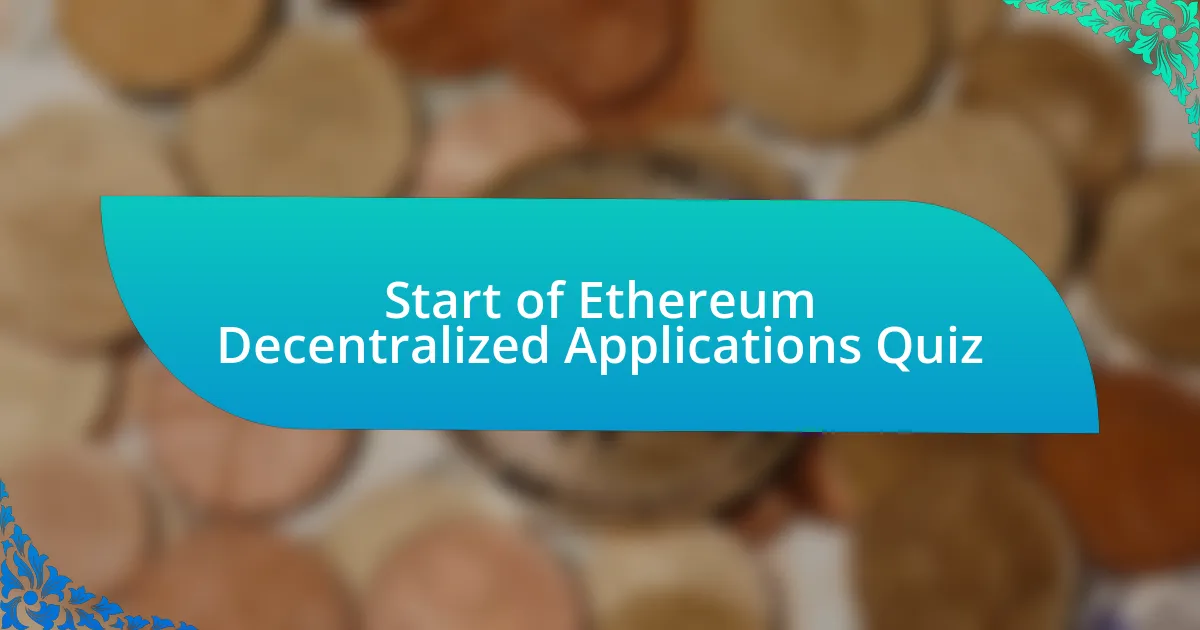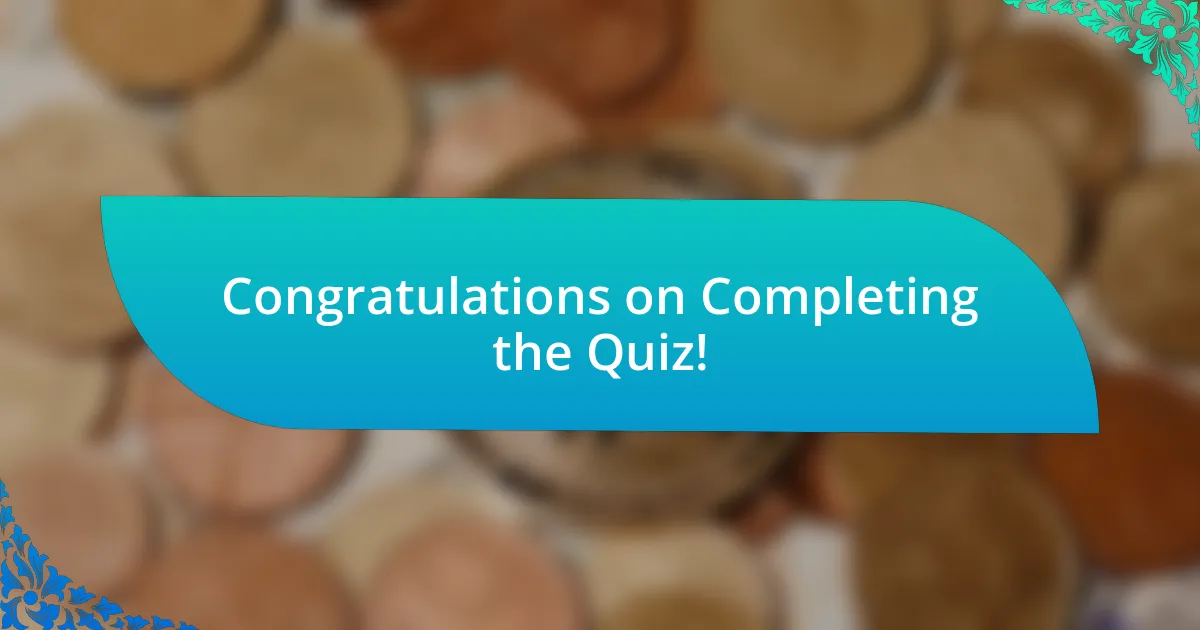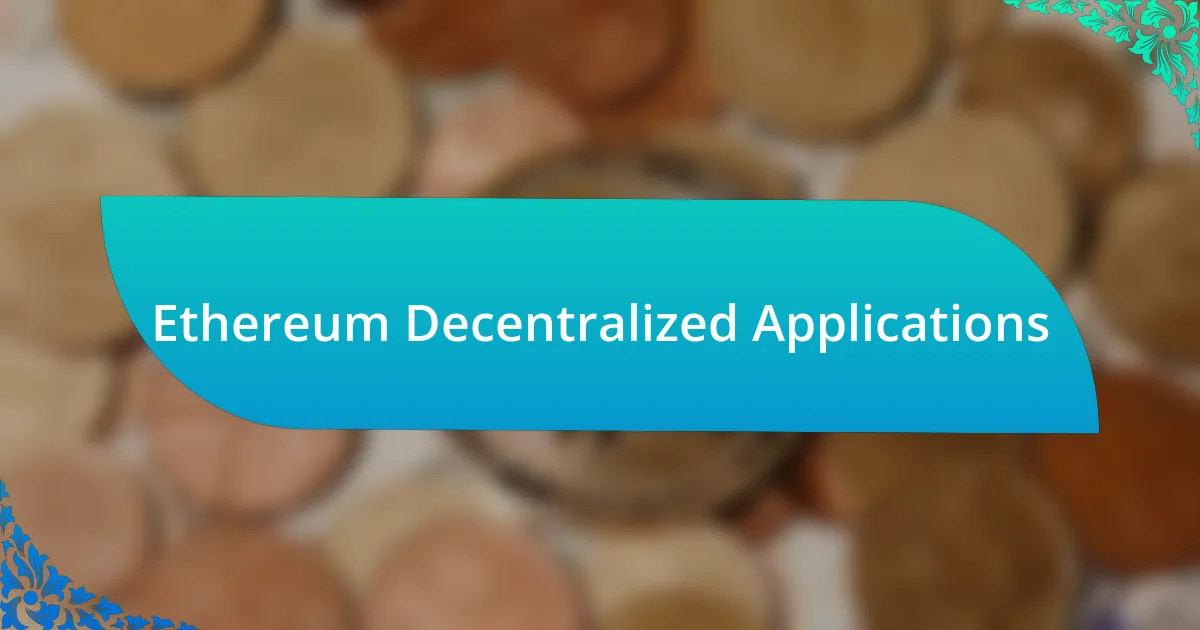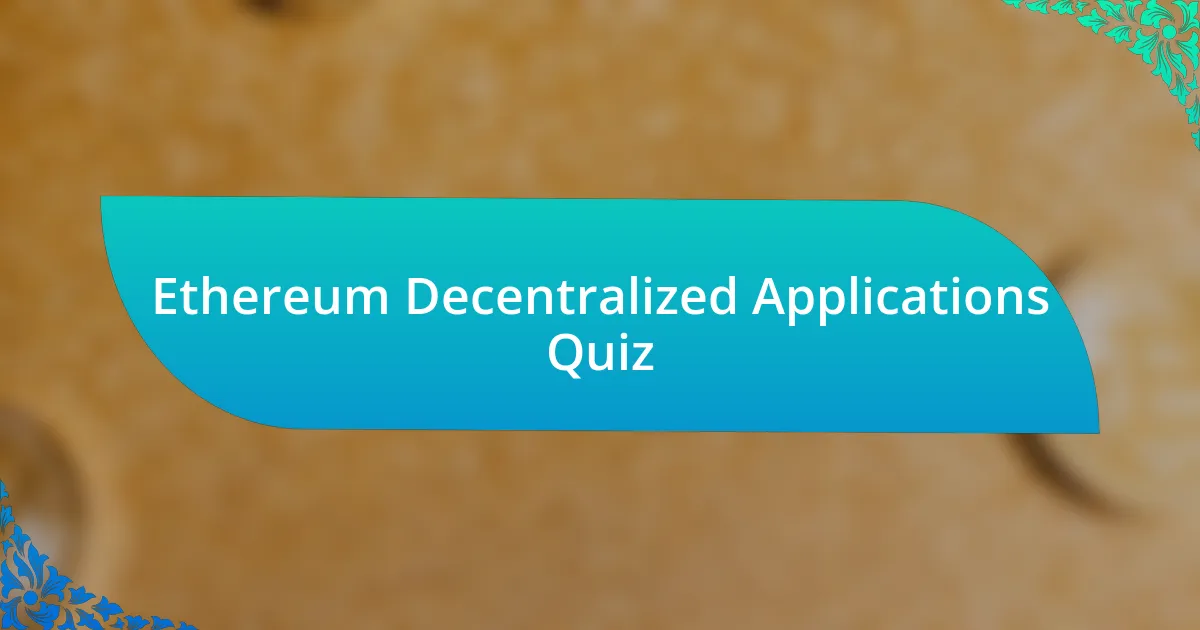
Start of Ethereum Decentralized Applications Quiz
1. What is the primary function of Ethereum?
- To create a centralized database for storing user information.
- To provide a platform for video and social media sharing.
- To enable developers to build and deploy smart contracts and decentralized applications (dApps).
- To serve as a currency for online transactions and exchanges.
2. Who are the original authors of Ethereum?
- Vitalik Buterin and Gavin Wood.
- Andreas Antonopoulos and Gavin Wood.
- Satoshi Nakamoto and Hal Finney.
- Charlie Lee and Vitalik Buterin.
3. What is the Ethereum Virtual Machine (EVM)?
- A special type of hardware used for mining Ether and other cryptocurrencies.
- A programming language specifically designed for building web applications.
- A centralized cloud service for hosting blockchain nodes.
- A decentralized virtual machine capable of handling scripts using the public nodes network, which is Turing complete and utilizes Gas as an internal pricing mechanism.
4. What is the value token for Ethereum?
- Litecoin (LTC)
- Ripple (XRP)
- Ether (ETH)
- Bitcoin (BTC)
5. What is a dApp?
- A type of centralized software used for data management and storage.
- A decentralized application created to take advantage of blockchain technologies, offering benefits like decentralization and open-source development.
- A mobile app designed to connect users to social media platforms.
- A proprietary application that requires a subscription for access.
6. Where are transactions recorded in Ethereum?
- In a centralized server.
- In a private ledger.
- In a secure database.
- In a public ledger.
7. What are the three types of Ethereum networks?
- Public, private, and consortium networks.
- Local, global, and federated networks.
- Centralized, conditional, and hybrid networks.
- Distributed, delegated, and internal networks.
8. How do you mine Ethers?
- By purchasing Ethers from an exchange.
- By participating in the network with tools like Geth CLI and helping add transactions to blocks.
- By generating random rewards through a lottery system.
- By solving complex mathematical problems without using any software.
9. What is a smart contract use case in real estate?
- A landlord can employ a smart contract to connect tenants with nearby jobs.
- A buyer can use a smart contract to rent a car directly from the owner.
- A developer can use a smart contract to issue shares in a new company.
- A seller can set up a smart contract to transfer property once the buyer transfers the property amount.
10. What is MetaMask?
- A type of Ethereum smart contract for managing digital assets.
- A popular browser-based Ethereum wallet used to interact with dApps on the Ethereum network.
- A decentralized exchange for trading cryptocurrencies.
- A programming language for developing Ethereum applications.
11. Which programming language is primarily used to write smart contracts and dApps?
- Solidity
- Java
- Python
- C++
12. What is Truffle?
- A type of rare mushroom used in fine dining and cooking.
- A testing and development environment for Ethereum that offers an asset pipeline for handling Ethereum-based projects.
- A digital currency used for online transactions.
- A popular video game series about racing.
13. What is block time and average block size in Ethereum?
- Block time is 14 seconds, and the average block size is 2 KB.
- Block time is 5 minutes, and the average block size is 1 MB.
- Block time is 12 seconds, and the average block size is 500 KB.
- Block time is 3 seconds, and the average block size is 256 MB.
14. Can transactions be kept hidden in the public Ethereum network?
- Yes, through hidden wallets.
- Yes, using private keys.
- Yes, with off-chain methods.
- No, all transactions are public.
15. Is the user’s private key used to sign transactions?
- Only with a password.
- Sometimes.
- No.
- Yes.
16. What is the functionality of Testnet?
- To manage static website hosting.
- To test and develop smart contracts and dApps without using real Ether.
- To enhance privacy in transactions.
- To connect to the Ropsten Network.
17. Do you need to use real Ether to test dApps and smart contracts?
- Only some dApps require real Ether.
- No, free Ether can be used in test networks.
- You can test dApps without any Ether at all.
- Yes, you must use real Ether for testing.
18. How does “spending” work in smart contracts?
- Actions that modify the smart contract cost money (Gas), while actions that return values do not.
- All actions in a smart contract require payment in Ether.
- Only actions that are successful need Gas payment.
- Gas is only used for transferring Ether between accounts.
19. What is Remix?
- A popular social media platform for sharing music.
- A website for learning programming languages.
- A useful online tool for deploying, testing, and developing smart contracts.
- A software for editing videos and photos online.
20. How do Bitcoin and Ethereum differ in checking the latest state?
- Bitcoin checks unspent transaction outputs (UTXO), while Ethereum checks previous blocks.
- Ethereum checks account balance, while Bitcoin checks unspent transaction outputs (UTXO).
- Bitcoin checks account balance, while Ethereum checks transaction history.
- Ethereum checks smart contract states, while Bitcoin checks wallet addresses.
21. What happens when the Gas runs out without the transaction being complete?
- The transaction remains in the queue until Gas is restored.
- All Gas fees are refunded, and the transaction is completed.
- All state changes are reversed, and the used Ethereum Gas is given to the miner.
- The transaction is saved for later, with no loss of funds.
22. What are uncle rewards in Ethereum?
- Rewards are paid to all users holding Ether in their wallets.
- Rewards are awarded to miners who create an uncle block included in a side chain.
- Rewards are given for solving complex mathematical puzzles.
- Rewards are given for verifying transactions in the main chain.
23. Which is NOT a type of Ethereum address?
- Receiving Address
- Contract Address
- Externally Owned Address
- Standard Address
24. When was Ethereum`s White paper published?
- 2013
- 2016
- 2015
- 2014
25. How many transactions per second could Ethereum process in January 2016?
- 15
- 25
- 10
- 50
26. How many hexadecimal characters does an Ethereum address have?
- 24
- 32
- 64
- 40
27. What is the primary difference between public and private Ethereum networks?
- Private networks are only accessible to developers.
- Private networks do not support dApps at all.
- Public networks are fully decentralized and transparent, while private networks are permissioned and controlled.
- Public networks operate under strict regulations.
28. What is the purpose of crowdsales in the crypto world?
- To create a marketplace for digital assets.
- To acquire new users for a software platform.
- To raise funds for the development of a project or business venture.
- To issue dividends to investors in cryptocurrencies.
29. What is a hard fork in the context of Ethereum?
- A simple update to increase transaction speed.
- A radical change to the network`s protocol, such as the hard fork after the DAO hack.
- A method for mining more Ether effectively.
- A process for creating new tokens on the network.
30. Which security primitives are NOT used in blockchains like Bitcoin and Ethereum?
- Digital Signatures.
- Symmetric Key Encryption.
- Certificates and Certificate Authorities.
- Hash Functions.

Congratulations on Completing the Quiz!
You’ve successfully completed the quiz on Ethereum Decentralized Applications! We hope you found the journey both informative and engaging. Assessing your knowledge on this dynamic topic allows you to reflect on what you know, as well as what you still want to explore. Each question has provided a glimpse into the innovative world of DApps, demonstrating their impact on the future of technology and finance.
Throughout the quiz, you likely learned about the key features of Ethereum, the versatility of smart contracts, and how decentralized applications function. Understanding these concepts is crucial as they form the backbone of this revolutionary technology. You now have a clearer picture of how DApps create a more open, user-centric digital landscape.
Ready to dive deeper? We invite you to explore the next section on this page. There, you’ll find comprehensive information about Ethereum Decentralized Applications that will broaden your understanding. Whether you’re a beginner or looking to expand your existing knowledge, this resource will help you navigate the exciting possibilities of Ethereum and its decentralized ecosystem.

Ethereum Decentralized Applications
What are Ethereum Decentralized Applications?
Ethereum decentralized applications, or dApps, are software applications that run on the Ethereum blockchain. They utilize smart contracts for backend functionality. Smart contracts automatically execute transactions and actions based on predefined conditions without the need for intermediaries. This allows dApps to operate in a trustless environment, enhancing security and transparency.
Key Features of Ethereum Decentralized Applications
Ethereum dApps possess unique features that set them apart from traditional applications. They are decentralized, meaning they are not controlled by a single entity. They are also open-source, allowing developers to review and modify the code. Interoperability is another feature, enabling dApps to interact with one another on the Ethereum network. Finally, user control over data is emphasized, as users maintain ownership of their private keys and can manage transactions directly.
Types of Ethereum Decentralized Applications
There are various types of Ethereum dApps, each serving different use cases. Financial dApps, such as decentralized exchanges and lending platforms, focus on blockchain-based finance. Gaming dApps integrate blockchain technology into gaming experiences, often allowing players to trade in-game assets. Social dApps aim to create decentralized social networks, enhancing user privacy. Finally, identity and data management dApps provide secure ways to manage digital identities and personal data on the blockchain.
Development of Ethereum Decentralized Applications
Developing dApps on Ethereum involves familiarity with programming languages like Solidity. Solidity is specifically designed for writing smart contracts on the Ethereum platform. Developers also utilize tools such as Truffle and Remix for coding, testing, and deploying their dApps. Interaction with the blockchain is usually facilitated through libraries like Web3.js or Ethers.js, which allow dApps to communicate with Ethereum nodes efficiently.
Challenges and Limitations of Ethereum Decentralized Applications
Despite their advantages, Ethereum dApps face several challenges. Scalability is a significant concern due to network congestion and high transaction fees, especially during peak usage. Security vulnerabilities in smart contracts can expose dApps to risks, as seen in notable hacks. User experience also presents a barrier; many users find blockchain technology complex, hindering wider adoption. Additionally, regulatory uncertainties can impact the development and use of dApps.
What are Ethereum decentralized applications?
Ethereum decentralized applications, or dApps, are software applications that run on the Ethereum blockchain. They are designed to be open-source and operate without central authority. Instead of relying on a server, dApps leverage smart contracts to execute code across a decentralized network. This ensures various benefits such as transparency, security, and resistance to censorship.
How do Ethereum decentralized applications work?
Ethereum decentralized applications work by utilizing smart contracts, which are self-executing agreements coded directly into the blockchain. When a user interacts with a dApp, it triggers the smart contract to perform specific functions, such as processing transactions or storing data. This interaction happens through a decentralized network of nodes that validate and execute the contract, eliminating the need for intermediaries. According to Ethereum’s whitepaper, this allows for more trustless interactions.
Where can Ethereum decentralized applications be accessed?
Ethereum decentralized applications can be accessed through web browsers that support Web3, which is a technology enabling the interaction with blockchain networks. Users typically require a cryptocurrency wallet, such as MetaMask, to connect to dApps. Popular platforms like OpenSea and Uniswap are examples of dApps extensively used in the decentralized finance (DeFi) and non-fungible token (NFT) sectors.
When were Ethereum decentralized applications first introduced?
Ethereum decentralized applications were first introduced with the launch of the Ethereum blockchain on July 30, 2015. The Ethereum platform was designed to support smart contracts, setting it apart from Bitcoin, which primarily functions as digital currency. The first significant decentralized application, known as the DAO (Decentralized Autonomous Organization), was launched in 2016, marking a pivotal moment in the evolution of dApps.
Who develops Ethereum decentralized applications?
Ethereum decentralized applications are developed by a diverse group of developers and organizations ranging from independent programmers to large companies. The development community is primarily composed of software engineers who are proficient in programming languages like Solidity, which is specifically designed for writing smart contracts on Ethereum. Notably, platforms like ConsenSys have played a significant role in fostering this developer community since before the platform’s launch.

